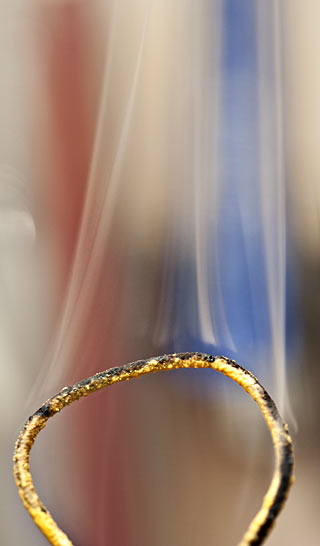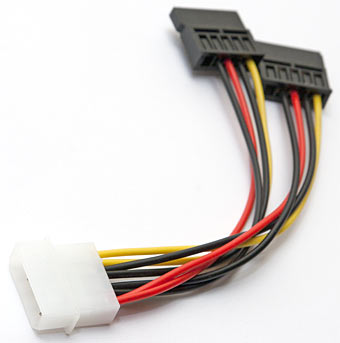
Atomic I/O letters column #125
Originally published 2011, in Atomic: Maximum Power ComputingReprinted here January 6, 2012 Last modified 16-Jan-2015.
This smoke wasn't magic
So yesterday I was just using my computer, and didn't change anything (just like everybody who calls phone support!), and then smoke came out. I'm quite proud of how fast I pulled the plug out of the wall.
My PC case has a removable 3.5 inch drive frame, and it turns out when I installed a new drive a month ago I pinched a yellow PSU wire (to an unused drive power plug) between the corner of the drive frame and the bottom of the case. The metal edge cut almost through the wire insulation, and it finally shorted out yesterday. That one wire ended up sort of dark brown instead of yellow.
The thing that surprised me though is that I thought, what the hell, it probably isn't going to get any MORE broken, and just snipped off the smoked wire and put some electrical tape on the end, then tried turning the computer back on again... and it works fine! Windows complained about being turned off instead of shut down, but that's all.
Have I actually damaged something in the PSU or elsewhere that's going to let go soon? Why didn't the PSU just blow a fuse when the wire was actively shorted and smoking? The PSU is a Corsair AX1200.
Julian

It's a shame this Web site isn't scratch-and-sniff.
Answer:
A proper short circuit on any of a PC PSU's power rails generally did, in the past, pop a fuse which you might or
might not be able to easily replace. Modern PSUs like your Corsair usually have more sophisticated overcurrent protection,
which just turns the PSU off. (This second situation can make the whole computer seem to be dead, if you don't know
to look for a short.)
If only a tiny bit of copper is contacting the earthed chassis, though, your short-circuit can have a high enough total resistance - the length of wire between the PSU and the short matters, too - to just consume most of the current capacity of whatever 12V rail it was. (It was definitely 12V, because that's what the yellow wires to the drive power plugs are.)
Modern beefy PSUs have a lot of 12V-rail current capacity. Even when they follow the ATX spec and split their total 12V current capacity between multiple rails, the capacity of each individual rail can still be hundreds of watts, as long as the total 12V budget isn't blown. Just picking one multi-rail PSU at random, one of the six 12V rails in an Antec Quattro 1200 (with the same overall rating as your PSU) cam deliver 38 amps, which at 12V is 456 watts.
Your Corsair is one of the ones that still does it the simple old-fashioned way, with exactly one rail per voltage. The AX1200 has a single 12V rail with a hundred-amp rating. You could start a pretty big motorcycle with it.
The wire from your PSU is probably 16 AWG at the fattest, and more likely 18 AWG. This is more than adequate for even monster overclocked gaming PCs. The chassis-wiring current capacity for 18 AWG is only 16 amps, but for applications like powering high-end video cards you use six-pin or eight-pin ATX12V "PCIe power" plugs, which have three and four +12V/ground wire pairs, respectively. A 16-amp rating on only a six-pin, three-wire-pair plug gives a total of 576 watts, so there's quite a lot of power headroom for even the most ridiculous dual-GPU ultra-cards. Those usually have at least a couple of six-pin power sockets, and often two eight-pinners.
(Officially, the six-pin ATX12V power plugs are only meant to be able to deliver 75 watts per plug, and the eight-pin ones 150 watts, but many PSUs can exceed this.)
In the real world, you can get away with exceeding the chassis-power rating for a given gauge of wire by a factor of two pretty much indefinitely, if the wire gets a bit of air cooling. Once you get to a factor of four or more, though, the wire can get hot enough that the PVC insulation softens, which frequently allows short-circuit problems to get worse. Higher heat also increases the wire's resistance; in a short-circuit situation, with a short enough piece of wire, this means the wire gets hotter and hotter in a classic "thermal runaway", and soon passes the smoke point for PVC insulation, whereupon it will commence contributing toxic vapours to your work environment.
If you had a PSU with split 12V rails and a mere 38 amps available to any one yellow wire, your short probably wouldn't have let the smoke out, unless the PSU turned out to substantially exceed the specified current before overcurrent protection kicked in. And a really solid short ought to trigger the protection, or blow a fuse, pretty much immediately. If your short falls somewhere in the middle, though, a beefy one-rail PSU like yours can easily do exactly what yours did.
As long as the hot wire didn't burn up anything else, there's no reason to suppose anything else in your PC is damaged. Just get rid of the wire with the compromised insulation, as you did, and carry on computing.
Computers and cats, the saga continues
I know static electricity can fry some computer hardware, and I know that the spark that does it can be so small you don't even notice it.
I really notice the sparks and crackling and fur-on-end that happens when I'm patting my cat on a dry day.
Could I fry a computer by using it while patting a cat? How incompatible are a laptop computer and a laptop cat?
Dean
Answer:
I don't want to say it's completely impossible to fry computer hardware by static-sparking the exterior of
the machine, especially when you're talking enough static charge to make clearly visible sparks. But it's really,
really unlikely. Only if some fairly-conductive path to a vulnerable component is accessible from the outside of the
computer could it be a problem. Dedicate yourself to sticking your fingers in optical drives or laptop-card slots
and you might be able to do it.
If you don't have the side off your computer case, though, the only damage caused by a sparky cat should be to your relationship with said cat when you spark it on the nose.
The malice of inanimate objects
My PC's 1Tb boot drive was full, so I got a new 2Tb Seagate and installed it and moved stuff onto it from C:.
About five seconds after I finished moving the data, the 2Tb drive failed. Spun up, sort of, otherwise dead like stone.
Right, stuff happens, OK, back to the shop it went and I got a warranty replacement, no drama. Undeleted most of the lost data from C: (thanks, PC Inspector!) and moved it to the new F:, again. Downloaded all my Steam games again.
That drive failed too. Took a week this time.
Went back to shop, batted eyelashes, twirled hair, got another replacement, this time a Samsung in case the Seagates were a bad batch.
You guessed it. Dead. A-fucking-gain. Three days.
Why does God hate me? How can I make him stop?
Caitlin

It doesn't look as if it's plotting your downfall, does it?
Answer:
Caitlin included a picture of the guts of her PC, but it was, in her words, a "gruesome blurry cameraphone photo",
unworthy of reproduction here. But it was good enough for me to extract the one piece of data that, after a little
more correspondence, located the culprit:
A $3 Molex-to-twin-SATA power plug adapter. Which, fortunately, was only powering one drive.
Maybe it was the adapter's "Molex" (old-style hard-drive power plug) socket, possibly the Molex plug going into it, or maybe they conspired. Anyhow, one or more of the contacts in there was intermittent, so as fan vibration and lunar tidal forces wiggled it around, it brutally varied the power going to the drives, causing errors and rather rapid death. When Caitlin got a new adapter and used it with a different Molex plug from the PSU, her fourth attempt at a working F: drive survived, at least the six weeks until my writing of this column.
Herewith, two more of the many and varied ways in which almost-unplugged connectors can screw you, from my own blessed experience:
If one or the other end of your computer's power cable is almost unplugged, the computer may turn off at random moments, making you suspect some dire hardware problem.
And if the big stupid Australian telephone plug on the end of your DSL-adapter cable is almost unplugged, you can have strangely slow Internet access, and not be able to reconnect when you reset the DSL adapter.
Take "grease nipple" joke as read
I read your guide on how to oil fans, so I think you might know about this.
I have a Sapphire HD 5850 reference-design graphics card, and the fan has started rattling. I tried to open it, but removing the sticker only revealed a solid brass or copper circle. Since I can't find a guide on how to lube a goddamn GPU blower fan, I'm turning to you!
Oh mighty Dan, do you know how to lube this damn fan?
Stevan

There's usually an accessible bearing on the frame side of a computer fan.
Answer:
If you peeled off the sticker on the top of the impeller - the part that spins - then you're probably looking at the
axle mounting point, which is a solid thing and not the source of your problem.
You need to get at the other end of the fan axle, so you'll have to take the cooler assembly apart. I don't know whether the standard 5850 cooler is easy to dismantle, but as long as you don't static-zap the card itself, you'll probably be able to get away with some butchery. Levering the side of the fan shroud assembly to dislodge clips, peeling off adhesive or what-have-you; any trouble you have with reassembling it later can probably be cured with tape.
(If you destroy your video card then I, of course, disclaim all responsibility.)
What I'd expect to find is a shroud held on with pretty simple clips, and a fan held on with screws, or split spring-pins that you can remove with needle-nosed pliers to squish the split end together.
The fan bearing may already be irretrievably worn, though. In that case, you can probably keep the card acceptably cool by tossing the shroud away and just bodging a bigger standard PC fan onto the board with cable ties and, again, tape.

